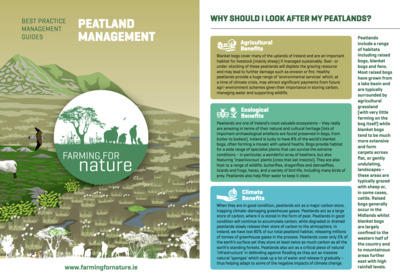{Tool} Peatland management - Best practice management guide. Creator(s): for Nature, Farming. Issuing Organisation(s): Farming for Nature. (2021)
![[thumbnail of Bildschirmfoto 2025-05-05 um 10.51.18.png]](/55592/1.hassmallThumbnailVersion/Bildschirmfoto%202025-05-05%20um%2010.51.18.png)  Preview |
Image (PNG)
- Cover Image
- English
1MB |
Preview |
PDF
- Published Version
- English
2MB |
Document available online at: https://www.farmingfornature.ie/your-farm/resources/best-practice-guides/peatland-management/
Summary
In this guide you will learn how to best manage peatland areas on your farm. You will learn what good peatland management looks like, learn about water levels and biodiversity, which additional actions you can take and also what to avoid.
| EPrint Type: | Practice tool |
|---|---|
| Teaser: | Explore the benefits of peatlands and how to best manage them on your farm. |
| What problem does the tool address?: | Peatlands include a range of habitats, including raised bogs, blanket bogs and fens. Most raised bogs have grown from a lake basin and are typically surrounded by agricultural grassland (with very little farming on the bog itself) while blanket bogs tend to be much more extensive and form carpets across flat, or gently undulating, landscapes – these areas are typically grazed with sheep or, in some cases, cattle. Raised bogs generally occur in the Midlands whilst blanket bogs are largely confined to the western half of the country and to mountainous areas further east with high rainfall levels. |
| What solution does the tool offer?: | Blanket bogs offer agricultural, ecological, and climate-related benefits. Agriculturally, they provide important grazing land for livestock, especially sheep, but improper management can lead to erosion or fire. Ecologically, peatlands support unique plant and animal species and help filter water. In terms of climate, peatlands act as significant carbon stores, trapping greenhouse gases when healthy, but releasing them when degraded. They also function as natural sponges, absorbing and slowly releasing water, which helps manage flooding and adapt to climate change. |
| Country: | Ireland |
| Type of Practice Tool: | Leaflets & guidelines |
| Keywords: | climate change, climate change adaptation, climate-smart agriculture, resilience, agricultural water management, cropping systems, arable farming, grasses, forage, soil management, biodiversity, nature conservation, environmental protection |
| Agrovoc keywords: | Language Value URI English climate change http://aims.fao.org/aos/agrovoc/c_1666 English climate change adaptation http://aims.fao.org/aos/agrovoc/c_1374567058134 English climate-smart agriculture http://aims.fao.org/aos/agrovoc/c_1361789093890 English resilience http://aims.fao.org/aos/agrovoc/c_1374480530924 English agricultural water management http://aims.fao.org/aos/agrovoc/c_e0257e3f English cropping systems http://aims.fao.org/aos/agrovoc/c_1971 English arable farming http://aims.fao.org/aos/agrovoc/c_36528 English grasses http://aims.fao.org/aos/agrovoc/c_3362 English forage http://aims.fao.org/aos/agrovoc/c_36108 English soil management http://aims.fao.org/aos/agrovoc/c_7176 English biodiversity http://aims.fao.org/aos/agrovoc/c_33949 English nature conservation http://aims.fao.org/aos/agrovoc/c_5092 English environmental protection http://aims.fao.org/aos/agrovoc/c_15898 |
| Subjects: | Soil > Soil quality Environmental aspects > Biodiversity and ecosystem services |
| Research affiliation: | Ireland European Union > Horizon Europe > OrganicClimateNET > selected tools European Union > Organic Farm Knowledge |
| Horizon Europe or H2020 Grant Agreement Number: | 101136880 |
| Related Links: | https://organic-farmknowledge.org/tool/55592, https://organicclimatenet.eu/, https://organic-farmknowledge.org/tool/55590 |
| Project ID: | OFK |
| Deposited By: | Rüger, Madelaine Lea |
| ID Code: | 55592 |
| Deposited On: | 05 May 2025 14:01 |
| Last Modified: | 05 May 2025 14:01 |
| Document Language: | English |
| Status: | Published |
Repository Staff Only: item control page

 Download Statistics
Download Statistics Download Statistics
Download Statistics
